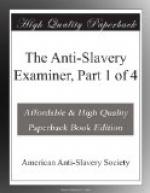“The report of the Select Committee, adverse to legislation on the subject of Abolition, was in these words: Resolved, as the opinion of this Committee, that it is INEXPEDIENT FOR THE PRESENT, to make any legislative enactments for the abolition of Slavery.” This Report Mr. Preston moved to reverse, and thus to declare that it was expedient, now to make legislative enactments for the abolition of slavery. This was meeting the question in its strongest form. It demanded action, and immediate action. On this proposition the vote was 58 to 73. Many of the most decided friends of abolition voted against the amendment; because they thought public opinion not sufficiently prepared for it, and that it might prejudice the cause to move too rapidly. The vote on Mr. Witcher’s motion to postpone the whole subject indefinitely, indicates the true state of opinion in the House.—That was the test question, and was so intended and proclaimed by its mover. That motion was negatived, 71 to 60; showing a majority of 11, who by that vote, declared their belief that “at the proper time, and in the proper mode, Virginia ought to commence a system of gradual abolition.”
7. THE CONGRESS OF THE UNITED STATES HAVE ASSERTED THIS POWER. The ordinance of ’87, declaring that there should be “neither slavery nor involuntary servitude,” in the North Western territory, abolished the slavery then existing there. The Supreme Court of Mississippi, in its decision in the case of Harvey vs. Decker, Walker’s Mi. Reps. 36, declared that the ordinance emancipated the slaves then held there. In this decision the question is argued ably and at great length. The Supreme Court of La. made the same decision in the case of Forsyth vs. Nash, 4 Martin’s La. Reps. 395. The same doctrine was laid down by Judge Porter, (late United States Senator from La.,) in his decision at the March term of the La. Supreme Court, 1830, in the case of Merry vs. Chexnaider, 20 Martin’s Reps. 699.
That the ordinance abolished the slavery then existing there is also shown by the fact, that persons holding slaves in the territory petitioned for the repeal of the article abolishing slavery, assigning that as a reason. “The petition of the citizens of Randolph and St. Clair counties in the Illinois country, stating that they were in possession of slaves, and praying the repeal of that act (the 6th article of the ordinance of ’87) and the passage of a law legalizing slavery there.” [Am. State papers, Public Lands, v. 1. p. 69.] Congress passed this ordinance before the United States Constitution was adopted, when it derived all its authority from the articles of Confederation, which conferred powers of legislation far more restricted than those conferred on Congress over the District and Territories by the United States Constitution. Now, we ask, how does the Constitution abridge the powers which Congress possessed under the articles of confederation?




